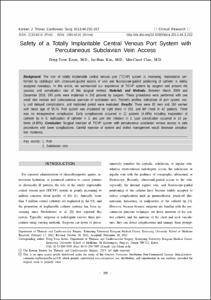KUMEL Repository
1. Journal Papers (연구논문)
1. School of Medicine (의과대학)
Dept. of Thoracic & Cardiovascular Surgery (흉부외과학)
Safety of a Totally Implantable Central Venous Port System with Percutaneous Subclavian Vein Access
- Keimyung Author(s)
- Keum, Dong Yoon; Kim, Jae Bum
- Journal Title
- Korean Journal of Thoracic and Cardiovascular Surgery
- Issued Date
- 2013
- Volume
- 46
- Issue
- 3
- Keyword
- Port; Subclavian vein
- Abstract
- Background
The role of totally implantable central venous port (TICVP) system is increasing. Implantation performed by radiologist with ultrasound-guided access of vein and fluoroscope-guided positioning of catheter is widely accepted nowadays. In this article, we summarized our experience of TICVP system by surgeon and present the success and complication rate of this surgical method.
Materials and Methods
Between March 2009 and December 2010, 245 ports were implanted in 242 patients by surgeon. These procedures were performed with one small skin incision and subcutaneous puncture of subclavian vein. Patient's profiles, indications of port system, early and delayed complications, and implanted period were evaluated.
Results
There were 82 men and 160 women with mean age of 55.74. Port system was implanted on right chest in 203, and left chest in 42 patients. There was no intraoperative complication. Early complications occurred in 11 patients (4.49%) including malposition of catheter tip in 6, malfunction of catheter in 3, and port site infection in 2. Late complication occurred in 12 patients (4.90%).
Conclusion
Surgical insertion of TICVP system with percutaneous subclavian venous access is safe procedures with lower complications. Careful insertion of system and skilled management would decrease complication incidence.
Keywords: Port, Subclavian vein
- Publisher
- School of Medicine
- Citation
- Dong-Yoon Keum et al. (2013). Safety of a Totally Implantable Central Venous Port System with Percutaneous Subclavian Vein Access. Korean Journal of Thoracic and Cardiovascular Surgery, 46(3), 202~207-202~207. doi: 10.5090/kjtcs.2013.46.3.202
- Type
- Article
- ISSN
- 2233-601X
- Appears in Collections:
- 1. School of Medicine (의과대학) > Dept. of Thoracic & Cardiovascular Surgery (흉부외과학)
- 파일 목록
-
-
Download
 oak-aaa-4557.pdf
기타 데이터 / 666.89 kB / Adobe PDF
oak-aaa-4557.pdf
기타 데이터 / 666.89 kB / Adobe PDF
-
Items in Repository are protected by copyright, with all rights reserved, unless otherwise indicated.